#Place de l'Opera
Explore tagged Tumblr posts
Text
Opera national de Paris

#Palais Garnier#Opera House#Beaux Arts#Baroque#Renaissance#Revival#Palladian#Architecture#Place de l'Opera#Street Scene#French Moments#Paris#European Union#Flag#France
111 notes
·
View notes
Video
100 years ago:


L'opéra Garnier, à Paris. par gregory lejeune Via Flickr :
#photo#vintage#monument#palais garnier#photography#carte postale#paris#palace#postcard#architecture#france#french#old#palais#opera#place de l'opera#patrimoine#europe#facade
5 notes
·
View notes
Text

Rue Madeleine, Place de l'Opera (1888) by Childe Hassam
93 notes
·
View notes
Text

-Rue Madeleine, Place de l'Opera-
63 notes
·
View notes
Text
Um.. Intro Post I guess??
Considering I don't really post original stuff that much I thought I'd make one so people have an idea of who they're talking to🤔
------------------------------------------------------------------------------ HI!!!!!!!!!!!! You can call me Ludie (or anything else you think of); am a minor so NSFW DNI. This is um. a tword blog; if you think that's weird (or you don't know what it is) this place is prob not for you😊|Other "normal" blog: @meatless-dusk
Yes yes I'll admit it, *deep breath*, I do like tickling but it's not a fetish nor a kink, I see it as wholesome and fun and a way of bonding and nothing else; and as indicated by the usename, I am mostly a lee (except for the occasional ler mood when it comes to certain people teehee)
I'm a bit socially awkward online, but I promise I'm not mean nor do I judge anyone so please come and chat!!! I'd love to be friends🥺
I have no idea what I'm gonna post here but I guess mostly random thoughts when I'm in the mood🤷♂️ (fun fact: I DO write fanfics once in a while, but they often end up unfinished and hence unposted due to SERIOUS procrastination,,,, if we become friends I might send you ideas and drafts tho
Fandoms and interests under cut👀 (it's gonna be looooooong)
I've seen a lot of stuff, or at least started a lot (normal font for stuff I've watched; italics for unfinished, or finished but I forgot a lot about; bold for current hyperfixation (if you ask me I'll probably rant about it) ); stuff that's on here has occupied my mind for at least a week (otherwise the list would be too long lol); in no specific order:
TV SERIES: -Sherlock -Doctor Who -Good Omens -Hazbin Hotel -Gentleman Jack -The Good Doctor
MOVIES: -Marvel (more specifically; avengers, thor, doctor strange, captain america, guardians of the galaxy, spiderman) -Harry Potter (and Fantastic Beasts -Batman (the christian bale/nolan version) -Tenet -The Greatest Showman -Wicked -The Lion King (and Mufasa) -How to Train Your Dragon -Wonka -The Hunger Games etc.,,,,
MUSICALS: -Phantom of the Opera -Cats -Les Miserables -Hairspray -Hamilton -Hadestown -Into The Woods -Wicked French: -Mozart L'Opera Rock -Notre Dame de Paris -Le Rouge et le Noir -Le Roi Soleil -Don Juan -Romeo et Juliette
BOOKS: -Warriors -Of Mice and Men -The Odyssey -Harry Potter -Percy Jackson -The Hunger Games -Wings of Fire -Sherlock Holmes -Good Omens -Fingersmith -Divergent -Neverwhere -and a loooooooooot more (ask me for details if you wanna know)
Other stuff I'm interested in: MBTI and Jungus 8 functions Psychology Linguistics Classical music Greek mythology
So... I guess that's all?? For now... might edit later... (shuffles around) 'Twas nice meeting you! :3
2 notes
·
View notes
Text
Photos from my Opera Garnier Trip 2 of 3
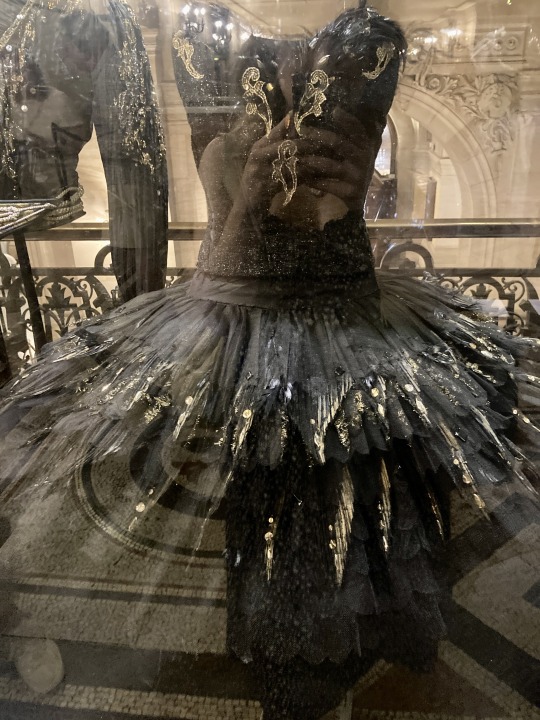
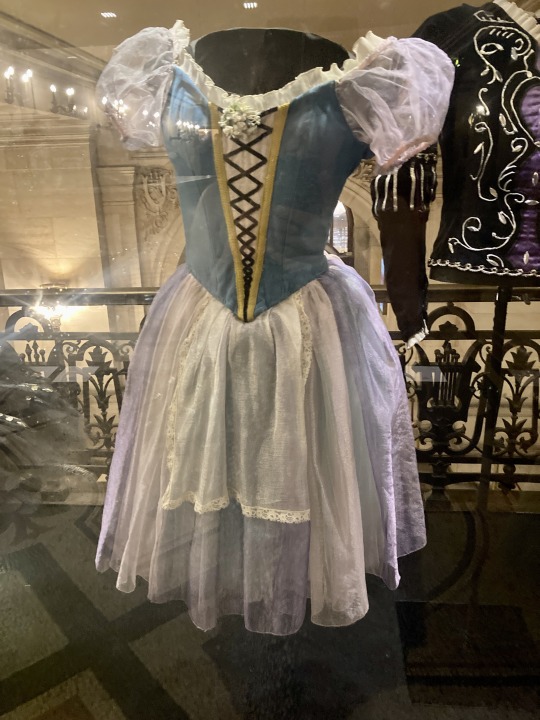

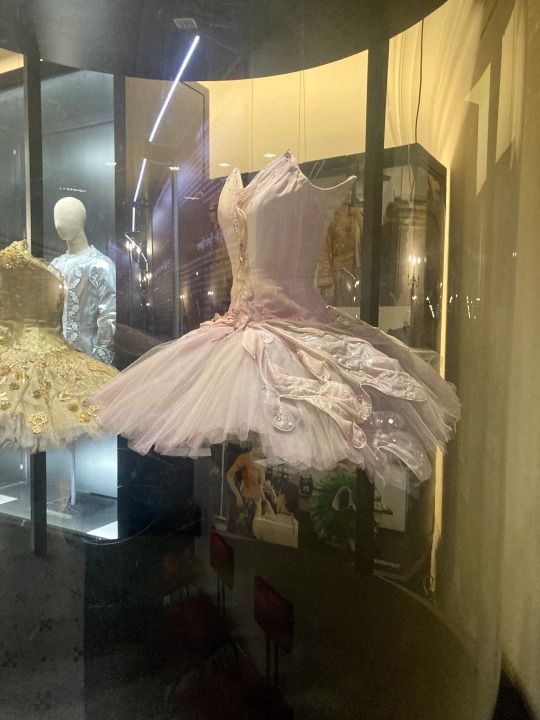
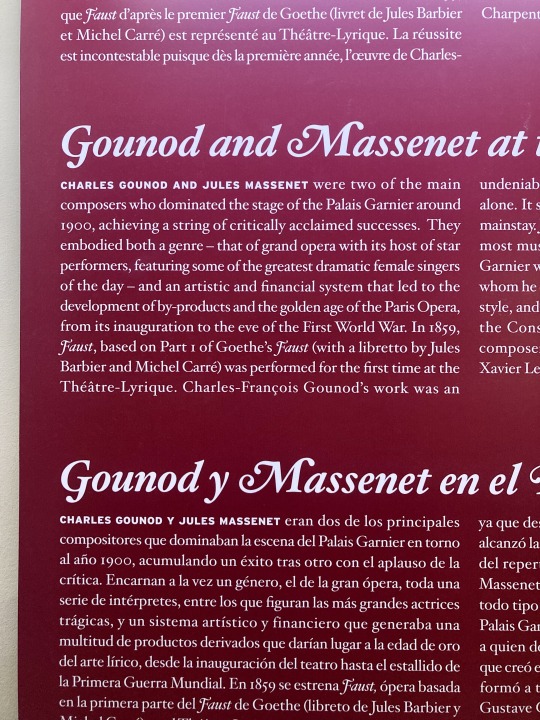
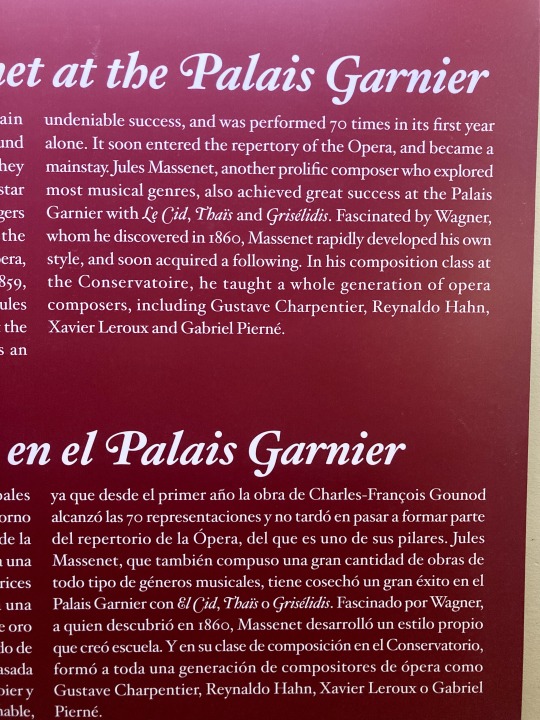
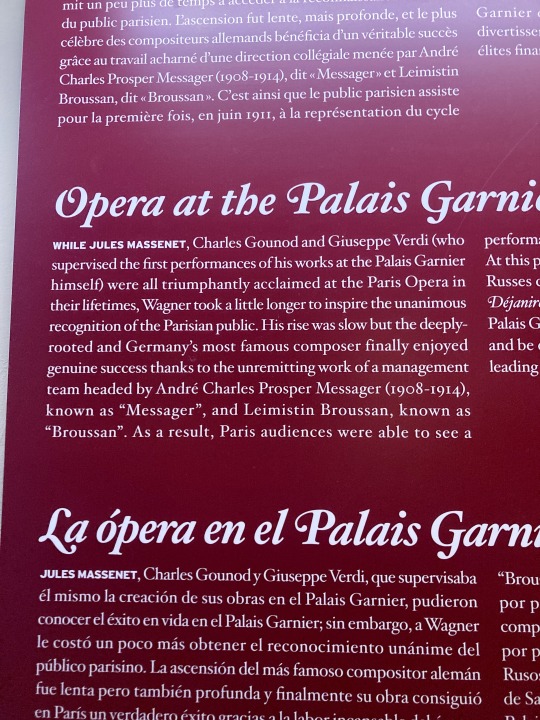

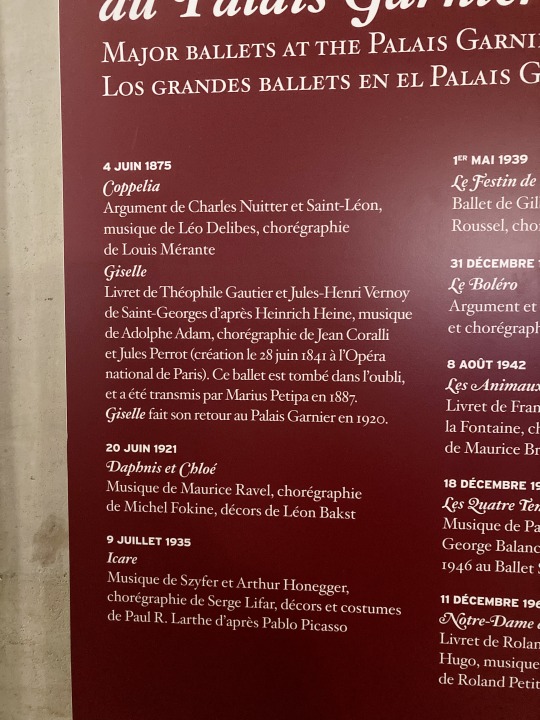

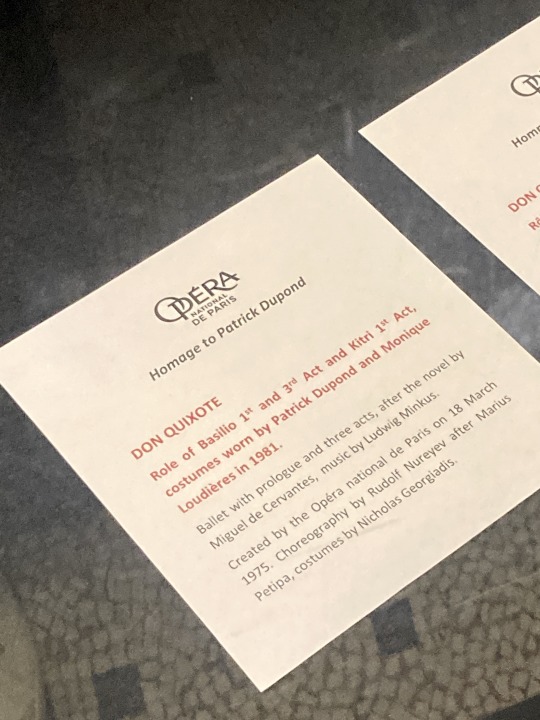
Took some photos of the exhibit up at the Opera Garnier for my own (cough cough) research purposes and thought it might be helpful for others! Thought the Don Quixote dress looked awfully familiar!
Transcript of the information under the cut:
Gounod and Massenet at the Palais Garnier
Charles Gounod and Jules Massenet were two of the main composers who dominated the stage of the Palais Garnier around 1900, achieving a string of critically acclaimed successes. They embodied both a genre - that of grand opera with its hoses of star performers, featuring some of the greatest dramatic female singers of the day - and an artistic and financial system that led to the development of by-products and the golden age of the Paris Opera from its inauguration to the eve of the First World War. In 1859, Faust, based on Part 1 of Goethe's Faust (with a libretto by Jules Barbier and Michel Carre) was performed for the first time at the Theater-Lyrique. Charles-Francois Gounod's work was an undeniable success and was performed 70 times in its first year alone. It soon entered the repertory of the Opera and became a mainstay. Jules Massenet, another prolific composer who explored most musical genres, also achieved great success at the Palais Garnier with Le Cid, Thais, and Griselidis. Fascinated by Wagner, whom he discovered in 1860, Massenet rapidly developed his own style, and soon acquired a following. In his composition class at the Conservatoire, he taught a whole generation of opera composers, including Gustave Charpentier, Reynaldo Hahn, Xavier Leroux, and Gabriel Pierne.
Opera at the Palais Garnier around 1900
While Jules Massenet, Charles Gounod, and Giuseppe Verdi (who supervised the first performances of his words at the Palais Garnier himself) were all triumphantly acclaimed at the Paris Opera in their lifetimes, Wagner took a little longer to inspire the unanimous recognition of the Parisian public. His rise was slow but the deeply-rooted and Germany's most famous composer finally enjoyed genuine success thanks to the unremitting work of a management team headed by Andre Charles Prosper Messager (1908-1914) known as "Messager", and Leimistin Broussan, known as "Broussan". As a result, Paris audiences were able to see a performance of the entire Ring cycle for the first time in June 1911. At this period, the Palais Garnier hosted Serge Diaghilev's Ballet Russes company, and Richard Strauss' Salome and Saint-Saens Dejanire both entered the repertory. During the Belle Epoque, the Palais Garnier was one of the chief places for Paris society to meet and be entertained, with an audience of subscribers made up of leading financiers, industrialists, and politicians.
Major Ballets at the Palais Garnier
4 June 1875
Coppelia - Argument de Charles Nuitter et Saint-Leon, Musique de Leo Delibes, choregraphie de Louis Merante
Giselle - Livret de Theophile Gautier et Jules-Henry Vernoy de Saint-Georges d'apres Heinrich Heine, musique de Adolphe Adam, choregraphie de Jean Coralli et Jules Perrot (creation le 28 Juin 1841 a l'opera national de Paris). Ce ballet est tombe dans l'oubli, et a ete transmis par Marius Petipa en 1887. Giselle fait son retour au Palais Garnier en 1920
20 Juin 1921
Daphnis et Chloe
musique de Maurice Ravel, choregraphie de Michel Fokine, decors de Leon Bakst
9 Jullet 1935
Icare
Musique de Szyfer et Arthur Honegger, choregraphie de Serge Lifar, decors et costumes de Paul R Larthe d'apres Pablo Picasso
21 notes
·
View notes
Text
An Old Man with a Pilgrim's Bottle, Pietro Bellotti, 17th century
Painting, oil on canvas - 0.915m x 1.125m

Un vecchio con la bottiglia del pellegrino, Pietro Bellotti, s.XVII. Pittura, olio su tela- 0.915 cm x 1.125 cm
(English / Español / Italiano)
AN OLD MAN WITH A PILGRIMINAL BOTTLE is the title of the painting kept at the National Gallery in London and attributed to the Brescian painter PIETRO BELLOTTI (1625-1700).
Of great beauty and dating from around the mid 17th century, the work presents an iconography that is difficult to interpret. It shows an old man leaning on a crutch with his left arm and next to a sphere, on which a rural scene is depicted. The man holds a simply decorated earthenware flask, known as a PILGRIMAN'S BOTTLE, an object present in western and eastern cultures since ancient times.
The name derives from the possibility of carrying the container during long journeys by sliding a string through the loops on the sides and placing it over the shoulder.
------------------------------------------------------------------------------
UN VIEJO CON LA BOTELLA DE PEREGRINO es el título del cuadro conservado en la National Gallery de Londres y atribuido al pintor bresciano PIETRO BELLOTTI (1625-1700).
De gran belleza y datada hacia mediados del siglo XVII, la obra presenta una iconografía difícil de interpretar. Muestra a un anciano apoyado en una muleta con el brazo izquierdo y junto a una esfera, en la que se representa una escena rural.
El hombre sostiene un frasco de barro decorado con sencillez, conocido como BOTELLA DE PEREGRINO, un objeto presente en las culturas occidentales y orientales desde la antigüedad.
El nombre deriva de la posibilidad de transportar el contenedor durante viajes largos deslizando un cordel por las trabillas de los laterales y colocándolo sobre el hombro.
-----------------------------------------------------------------------------
UN VECCHIO CON LA BOTTIGLIA DEL PELLEGRINO è il titolo del dipinto conservato presso la National Gallery di Londra e attribuito al pittore bresciano PIETRO BELLOTTI (1625-1700).
Di grande bellezza e databile intorno alla metà del '600, l'opera presenta un'iconografia di difficile interpretazione. Mostra un anziano appoggiato con il braccio sinistro a una stampella e vicino a una sfera, sulla quale è raffigurata una scena campestre.
L'uomo regge una fiasca in terracotta decorata semplicemente, detta BOTTIGLIA DEL PELLEGRINO, un oggetto presente nelle culture occidentali e orientali sin dai tempi più remoti.
Il nome deriva dalla possibilità di trasportare il contenitore durante i lunghi viaggi, facendo scorrere un laccio nei passanti posti sui fianchi e mettendolo a tracolla.
Credito: ArteinControluce
0 notes
Video
youtube
The Execution of Mary Queens of Scots (1895) Alfred Clark
The Execution of Mary Queen of Scots is a film directed by Albert Clark and produced by the Edison Manufacturing Company; the film represents the historical episode of the beheading of Mary Stuart, Queen of Scots, it is the first film to feature a editing cut and the first to use a special effect (00:13). It was shot on August 28, 1895, at Edison Laboratory in West Orange.
To show the decapitation of Mary Stuart (played by Robert Thomae, secretary and treasurer of the Edison company), the cameraman, William Heise, stops the camera at the moment the executioner raises the axe, Thomae is replaced by a dummy, and the action resumes. Clark and Heise only used the stop-motion substitution on this occasion and did not think of developing it further. Instead, Georges Méliès did, who discovered the same trick by chance one day while filming in the Place de l'Opera and his camera stopped. Unlike Clark and Heise, Méliès immediately set to work making films that exploited the newly discovered trick. The first was The Vanishing Lady (1896)
youtube
0 notes
Text
Gustav Mahler Symphony №5 in C sharp minor

Orchestre national de l'opera de Monte Carlo, direction: Antonio de Almeida Gustav Mahler, a renowned composer of the late 19th and early 20th centuries, left an indelible mark on the world of classical music. Among his many influential works, Symphony No. 5 in C sharp minor stands out as a testament to his genius. Gustav Mahler composed Symphony No. 5 between 1901 and 1902, during a period of personal and professional turmoil. It was a time of transition for Mahler, as he had recently experienced the loss of his young daughter and was also facing challenges in his conducting career. This symphony reflects the emotional journey he underwent during this turbulent phase. Symphony No. 5 is composed of five movements, each with its distinct character and musical language: a) Trauermusik (Funeral Music): The symphony opens with a funeral march, setting a somber and introspective tone. b) Stürmisch bewegt, mit größter Vehemenz (Stormily agitated, with the greatest vehemence): The second movement contrasts the first with its energetic and tumultuous nature, showcasing Mahler's mastery of orchestration. c) Scherzo: The third movement introduces a more playful and light-hearted atmosphere, with moments of humor and dance-like melodies. d) Adagietto: The fourth movement, perhaps the most famous, is a tender and introspective Adagietto for strings and harp. It evokes a sense of profound longing and emotional depth. e) Rondo-Finale: The final movement brings the symphony to a grand and triumphant conclusion, incorporating various themes from earlier movements. Mahler's Symphony No. 5 explores a wide range of themes and emotions. It seamlessly weaves together elements of joy, sorrow, love, and hope, creating a deeply expressive and cathartic musical journey. The contrasting moods and textures within each movement reflect the complexities of the human experience. Symphony No. 5 is known for its ability to evoke powerful emotions in listeners. From the melancholic opening funeral march to the transcendent beauty of the Adagietto, this symphony takes the audience on an emotional rollercoaster. It captures the essence of the human condition, touching on themes of love, loss, and the search for meaning. Gustav Mahler Symphony No. 5 in C sharp minor stands as a testament to the composer's ability to convey deep emotions through music. Its rich and complex structure, coupled with its profound emotional impact, has solidified its place as a symphonic masterpiece. Through its five movements, Mahler invites us to explore the depths of our own emotions and experiences, leaving an enduring impression on all who encounter this remarkable musical composition.
https://rumble.com/v1xsbwa-gustav-mahler-symphony-5-in-c-sharp-minor.html?mref=17947j&mc=9fatg
#classicalmusic#GustavMahler#SymphonyNo5#Csharpminor#musicalcomposition#classicalcomposer#orchestralmusic#romanticera#symphonicmasterpiece
0 notes
Text
Garnier Palace ❁𓂅 𓄼ꕤ༘ Paris

#French Moments#Palais Garnier#Opera House#Beaux Arts#Baroque#Renaissance#Revival#Palladian#Architecture#Art#Statue#Gilded#Sculpture#Place de l'Opera#Street Scene#Flag#Paris#France
118 notes
·
View notes
Photo

The metro under construction on Place de l’Opera, Paris
#Architecture#engineering#metropolitain#construction#place de l'opera#opera#Paris#paris history#paris architecture#public transportation#history
166 notes
·
View notes
Text

-Rue Madeleine, Place de l'Opera-
43 notes
·
View notes
Photo
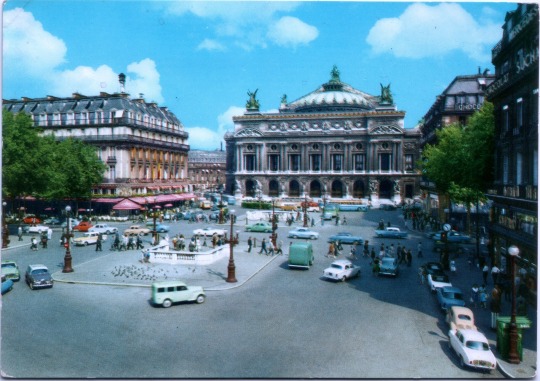

Párizs, 01-10-1962
Kedves Etus és Gyuri.
Az ünnepekre küldött jó kívánságaitokért köszönet és mi is hasonló legjobbakat kívánjuk nektek.
Paris - Place de l’Opera // The Opera Square
Random post || Postcards on Google Maps
4 notes
·
View notes
Photo

At noon on a spring day in Paris some years ago, an old motor truck broke down in the center of the Place de l'Opera, requiring the driver to spend a half an hour under it to make the repair. After apologizing for the trouble he had caused the policeman who had been directing the traffic around him, the truckman drove away- to collect several thousand dollars from friends who had bet that he could not lie on his back for 30 minutes at the busiest hour in the middle of the busiest street in Paris. He was Horace de Vere Cole, England’s celebrated practical joker.”- Collier’s 1948
14 notes
·
View notes
Photo

Three Undergound Metro Lines Crossing Each other At The Place De L'opéra In Paris
Photographer: AlarmedYoshi
#alarmedyoshi#photographer#underground metro lines#place de l'opera#paris#france#engineering#infrastructure
1 note
·
View note
Photo

no reason behind this drawing, i just like flowers
yall already know
#hhh click for better quality tumblr hates me :')#phantom of the opera#le fantome de l'opera#poto#erik#poto erik#artists on tumblr#crows art#chrysanthemum#forget me nots#the flowers in case anyone was curious#chrysanthemums represent death in some places in europe#which i thought was fitting#and i chose forget me nots for obvious reasons#sorry im a flower enthusiast xO
209 notes
·
View notes
